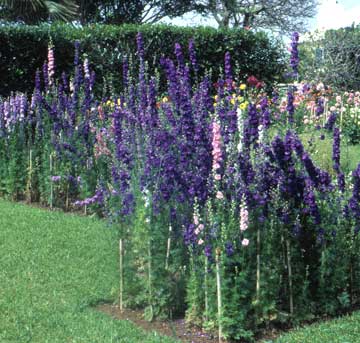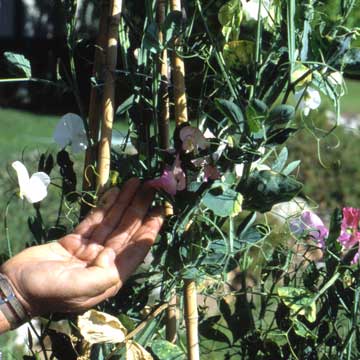





 Tall plants like these larkspurmay need staking to keep thestems straight.
Tall plants like these larkspurmay need staking to keep thestems straight.
Many annuals are neat and tidy in their growth and habit. They amble along the ground or form low mounds of flowers and foliage that are always attractive, even after a heavy summer rainstorm. Some plants grow tall and straggly. Without the help of a few well-placed stakes or some string, their stems flop about, giving a decidedly untidy look to the garden.
After you've used stakes to tidy up your annuals, install edging for a neat flower bed border. Click here to learn how.
continue reading below Fragrant sweet peas need a support
to climb.
Fragrant sweet peas need a support
to climb.
Pea-Staking Pea-staking is an ancient method of holding up plants. Branches pruned from trees are spread about and plants grow up between the twigs, eventually covering them with foliage. (The term "pea-staking" originated in English vegetable gardens, where such natural stakes were used to hold up pea vines.)
Cat's Cradle A cat's cradle results from winding green garden twine back and forth and diagonally across four wooden or bamboo stakes set at the corners of a plot. Bamboo Stakes Bamboo stakes (both real and plastic) or thin but straight wooden stakes can be used to support single-stemmed plants. Use special plastic clips, bits of string, or twist ties to hold the stems fast.
Many garden supply catalogues now offer interlocking stakes made of a green plastic-coated wire, which can be formed in many shapes, from a simple square to a long, spiral "S." And loops of the same plastic are now sold that ride up and down straight supports, enabling the loops to grow with the plants.
Climbing annuals, such as morning-glories, cup-and-saucer vine (Cobaea scandens), hops (Humulus spp.), sweet peas (Lathyrus odoratus), and scarlet runner bean (Phaseolus coccineus), need tall, vertical supports. You can grow most of these plants on trellises, latticework, or a series of vertical strings, as described below. Hop vines are heavier and need a sturdy support. Train hops on a tripod made of wooden poles lashed together at the top or on a stout trellis or arbor. Hop vines are excellent for shading a porch, and their large leaves make them a good choice to cover a dilapidated shed or to screen the compost pile from view.
Trellises Trellises for other climbing annuals can take a variety of forms. They may be either freestanding or placed against a wall. Flat trellises are usually made of wood strips that are arranged in lattice patterns, fans, or geometric shapes. You can buy them or build your own.
If your front porch is enclosed by a wooden railing, you can plant morning-glories or other thin-stemmed vines to screen, shade, and decorate the porch. Screw a series of small metal hooks (like the ones sold to hang coffee cups), spaced at regular intervals, into the railing and the roof above, then tie string or fishing line between the hooks. Plant the vines in pots or rectangular planters, so their stems can climb the strings.
Copyright © www.100flowers.win Botanic Garden All Rights Reserved